Numerical Investigation of the Hydrodynamic Characteristics of a Novel Bucket-Shaped Permeable Breakwater Using OpenFOAM
Abstract
:1. Introduction
2. Numerical Model Establishment
2.1. Governing Equations and Boundary Conditions
2.2. Wave Generation and Wave Absorption Methods
2.3. Wave Dissipation Characteristic Coefficient
2.4. Structure Model
3. Numerical Model Validation
3.1. Physical Model Test Settings
3.2. Spatiotemporal Verification
3.3. Wave Generation Validation
3.4. Model Test Verification
4. Hydrodynamic Characteristics of Bucket-Shaped Permeable Breakwater
4.1. Numerical Simulation Parameter Settings
4.2. The Effect of Porosity on Wave Dissipation Performance
4.3. The Effect of Opening Shape on Wave Dissipation Performance
4.4. The Effect of the Number of Openings on Wave Dissipation Performance
4.5. The Effect of Opening Position on Wave Dissipation Performance
4.6. The Effect of Porosity on Wave Pressure
5. Conclusions
- The three-dimensional numerical wave flume based on OpenFOAM constructed in this paper can effectively simulate the interaction process between waves and the bucket-shaped permeable breakwater.
- Within the range of relative wavelength L/D between 6.7 and 12.7, relative wave height H/d between 0.175 and 0.275, changes in wavelength had a limited impact on the wave-dissipating performance of the bucket-shaped permeable breakwater. This indicates that the bucket-shaped permeable breakwater with this porosity has a stable wave dissipation effect within a specific wavelength range. When designing this type of breakwater, it is possible to consider a broader range of wave conditions, reducing the dependence on precise wave condition predictions, lowering design and maintenance costs, and enhancing the safety of coastal areas.
- When the bucket porosity is 12%, the dissipation coefficient reaches its maximum value, indicating that the bucket-shaped permeable breakwater has the best overall wave dissipation performance at this porosity. If the focus is on reducing wave pressure, wave reflection, and water exchange between the inside and outside of the port, a higher porosity is preferable. A lower porosity is advisable if the focus is on maintaining calm waters within the port.
- The wave dissipation performance of the bucket-shaped permeable breakwater mainly depends on the porosity and is less related to the shape and number of openings. In practical applications, we can flexibly determine the shape and number of openings based on the stress-strain condition after perforation, construction difficulty, and aesthetic requirements.
- Higher opening positions help reduce wave reflection and increase wave energy transmission and dissipation within the structure, thereby reducing the impact of waves on the surrounding coastline. In practical engineering, we can adjust the wave dissipation effect of the structure by changing the opening positions to meet specific project requirements. For example, higher opening positions are preferable to reduce wave reflection in front of the bucket, and lower opening positions are preferable to minimize wave transmission through the bucket. For overall wave dissipation performance, higher opening positions are advisable.
- The connecting wall of the bucket-shaped permeable breakwater experiences the most significant wave impact. In practical engineering applications, we should reinforce the connecting wall.
Author Contributions
Funding
Institutional Review Board Statement
Informed Consent Statement
Data Availability Statement
Conflicts of Interest
References
- Jarlan, G.E. A Perforated Vertical Wall Breakwater. Dock Harb. Auth. 1961, 486, 394–398. [Google Scholar]
- Tanimoto, K.; Yoshimoto, Y. Theoretical and Experimental Study of Reflection Coefficient for Wave Dissipating Caisson with a Permeable Front Wall; Report of the Port and Harbour Research Institute: Yokosuka, Japan, 1982; pp. 43–77. [Google Scholar]
- Wu, G.S. Design and application of perforated caisson wave-reducing structure. Port. Eng. Technol. 1982, 2, 90–113. [Google Scholar]
- Fugazza, M.; Natale, L. Hydraulic Design of Perforated Breakwaters. J. Waterw. Port. Coast. Ocean. Eng. 1992, 118, 1–14. [Google Scholar] [CrossRef]
- Cox, R.J.; Horton, P.R.; Bettington, S.H. Double Walled, Low Reflection Wave Barriers. In Proceedings of the Coastal Engineering 1998, Copenhagen, Denmark, 22–26 June 1998; Volume 1–3, pp. 2221–2234. [Google Scholar]
- Bergmann, H.; Oumeraci, H. Wave Pressure Distribution on Permeable Vertical Walls. In Proceedings of the Coastal Engineering 1998, Copenhagen, Denmark, 22–26 June 1998; American Society of Civil Engineers: Copenhagen, Denmark, 1999; pp. 2042–2055. [Google Scholar]
- Neelamani, S.; Vedagiri, M. Wave Interaction with Partially Immersed Twin Vertical Barriers. Ocean. Eng. 2002, 29, 215–238. [Google Scholar] [CrossRef]
- Rao, S.; Shirlal, K.G.; Varghese, R.V.; Govindaraja, K.R. Physical Model Studies on Wave Transmission of a Submerged Inclined Plate Breakwater. Ocean. Eng. 2009, 36, 1199–1207. [Google Scholar] [CrossRef]
- Takahashi, S.; Kotake, Y.; Fujiwara, R.; Isobe, M. Performance Evaluation of Perforated-Wall Caissons by VOF Numerical Simulations. In Proceedings of the Coastal Engineering 2002, Cardiff, UK, 7–12 July 2002; World Scientific Publishing Company: Cardiff, UK, 2003; pp. 1364–1376. [Google Scholar]
- Wu, H.; Sun, D.P.; Xia, Z.S. Nonlinear numerical simulation of wave interaction with large wave-transmitting structure with big holes. Ocean. Eng. 2010, 28, 117–122. [Google Scholar] [CrossRef]
- Wang, K.; Zhang, X.; Gao, X. Study on Scattering Wave Force of Horizontal and Vertical Plate Type Breakwaters. China Ocean. Eng. 2011, 25, 699–708. [Google Scholar] [CrossRef]
- Gui, J.S.; Zhang, K.X.; Xia, X. Numerical study on hydrodynamic characteristics of perforated Pile-supported vertical wall breakwater. Chin. J. Hydrodyn. 2020, 35, 584–591. [Google Scholar] [CrossRef]
- Yin, Z.G.; Li, Y.; Li, J.H.; Zheng, Z.H.; Ni, Z.H.; Zheng, F.X. Experimental and Numerical Study on Hydrodynamic Characteristics of a Breakwater with Inclined Perforated Slots under Regular Waves. Ocean. Eng. 2022, 264, 112190. [Google Scholar] [CrossRef]
- Wang, D.X.; Dong, S.; Sun, J.W. Numerical Modeling of the Interactions between Waves and a Jarlan-Type Caisson Breakwater Using OpenFOAM. Ocean. Eng. 2019, 188, 106230. [Google Scholar] [CrossRef]
- Wang, D.X.; Dong, S.; Fang, K.Z. Breaking Wave Impact on Perforated Caisson Breakwaters: A Numerical Investigation. Ocean. Eng. 2022, 249, 110919. [Google Scholar] [CrossRef]
- Kottala, P.; Koley, S.; Sahoo, T. Surface Gravity Wave Scattering by Multiple Slatted Screens Placed near a Caisson Porous Breakwater in the Presence of Seabed Undulations. Appl. Ocean. Res. 2021, 111, 102675. [Google Scholar] [CrossRef]
- Li, X.Y.; Wang, Q.; Zhu, X.S.; Guo, W.J.; Zhang, J.B.; Wang, L.X.; Zhang, Z.C.; Li, Q. Numerical study on the wave attenuation performance of the different plate type open breakwaters. J. Ship Mech. 2019, 23, 1198–1209. [Google Scholar] [CrossRef]
- Li, X.Y.; Wang, L.X.; Wang, Q.; Xie, T.; You, Z.J.; Song, K.Z.; Xie, X.M.; Wan, X.; Hou, C.Y.; Wang, Y.K. A Comparative Study of the Hydrodynamic Characteristics of Permeable Twin-Flat-Plate and Twin-Arc-Plate Breakwaters Based on Physical Modeling. Ocean. Eng. 2021, 219, 108270. [Google Scholar] [CrossRef]
- Sammarco, P.; De Finis, S.; Cecioni, C.; Bellotti, G.; Franco, L. ARPEC: A Novel Staggered Perforated Permeable Caisson Breakwater for Wave Absorption and Harbour Flushing. Coast. Eng. 2021, 169, 103971. [Google Scholar] [CrossRef]
- Zhou, W.Z.; Cheng, Y.Z.; Lin, Z.Y. Numerical Simulation of Long-Wave Wave Dissipation in near-Water Flat-Plate Array Breakwaters. Ocean. Eng. 2023, 268, 113377. [Google Scholar] [CrossRef]
- Tagliafierro, B.; Crespo, A.J.C.; González-Cao, J.; Altomare, C.; Sande, J.; Peña, E.; Gómez-Gesteira, M. Numerical Modelling of a Multi-Chambered Low-Reflective Caisson. Appl. Ocean. Res. 2020, 103, 102325. [Google Scholar] [CrossRef]
- Chen, J.J.; Qi, X.H. Selection and application of bucket-based structure in other areas. China Harb. Eng. 2019, 39, 103–106. [Google Scholar] [CrossRef]
- Lian, X.B.; Chen, X. Key construction technology of plug-bucket-based structure breakwater. China Harb. Eng. 2016, 36, 49–52. [Google Scholar] [CrossRef]
- Ministry of Transport of the People’s Republic of China. JYS/T 167-16-2020; Design and Construction Specification for Bucket-base Structures of Port and Waterway Engineering. China Communications Press: Beijing, China, 2020. [Google Scholar]
- Cai, Z.Y.; Yang, L.G.; He, Y.; Huang, Y.H. Installation of new bucket foundation breakwater and its influence on stability. Chin. J. Geotech. Eng. 2016, 38, 2287–2294. [Google Scholar] [CrossRef]
- Yang, L.G. Stability analysis of new bucket foundation breakwater structure based on quasi-static method. Hydro-Sci. Eng. 2015, 5, 96–102. [Google Scholar] [CrossRef]
- Yang, L.G.; Cai, Z.Y. A computation method for stability against overturning of embedded bucket foundation breakwater. Hydro-Sci. Eng. 2015, 4, 61–68. [Google Scholar] [CrossRef]
- Wang, D.X.; Sun, J.W.; Gui, J.S.; Ma, Z.; Ning, D.Z.; Fang, K.Z. A Numerical Piston-Type Wave-Maker Toolbox for the Open-Source Library OpenFOAM. J. Hydrodyn. 2019, 31, 800–813. [Google Scholar] [CrossRef]
- Weller, H.G.; Tabor, G.; Jasak, H.; Fureby, C. A Tensorial Approach to Computational Continuum Mechanics Using Object-Oriented Techniques. Comput. Phys. 1998, 12, 620–631. [Google Scholar] [CrossRef]
- Wilcox, D.C. Turbulence Modeling for CFD; DCW Industries: La Canada Flintridge, CA, USA, 2006; ISBN 978-1-928729-08-2. [Google Scholar]
- Hirt, C.W.; Nichols, B.D. Volume of Fluid (VOF) Method for the Dynamics of Free Boundaries. J. Comput. Phys. 1981, 39, 201–225. [Google Scholar] [CrossRef]
- Chen, L.F.; Zang, J.; Hillis, A.J.; Morgan, G.C.J.; Plummer, A.R. Numerical Investigation of Wave–Structure Interaction Using OpenFOAM. Ocean. Eng. 2014, 88, 91–109. [Google Scholar] [CrossRef]
- Chen, L.F.; Sun, L.; Zang, J.; Hillis, A.J.; Plummer, A.R. Numerical Study of Roll Motion of a 2-D Floating Structure in Viscous Flow. J. Hydrodyn. 2016, 28, 544–563. [Google Scholar] [CrossRef]
- Larsen, J.; Dancy, H. Open Boundaries in Short Wave Simulations—A New Approach. Coast. Eng. 1983, 7, 285–297. [Google Scholar] [CrossRef]
- Somervell, L.T.; Thampi, S.G.; Shashikala, A.P. Estimation of Friction Coefficient for Double Walled Permeable Vertical Breakwater. Ocean. Eng. 2018, 156, 25–37. [Google Scholar] [CrossRef]
- JTS 154-2018; Code of Design for Breakwaters and Revetments. Ministry of Transport of the People’s Republic of China. China Communications Press: Beijing, China, 2018.
- JTS/T 231-2021; Technical Code of Modelling Test for Port and Waterway Engineering. Ministry of Transport of the People’s Republic of China. China Communications Press: Beijing, China, 2021.
- Procedure for Estimation and Reporting of Uncertainty Due to Discretization in CFD Applications. J. Fluids Eng. 2008, 130, 078001. [CrossRef]
- Goda, Y.; Suzuki, Y. Estimation of Incident and Reflected Waves in Random Wave Experiments. In Proceedings of the Coastal Engineering 1976, Honolulu, HI, USA, 11 July 1976; American Society of Civil Engineers: Honolulu, HI, USA, 1977; pp. 828–845. [Google Scholar]
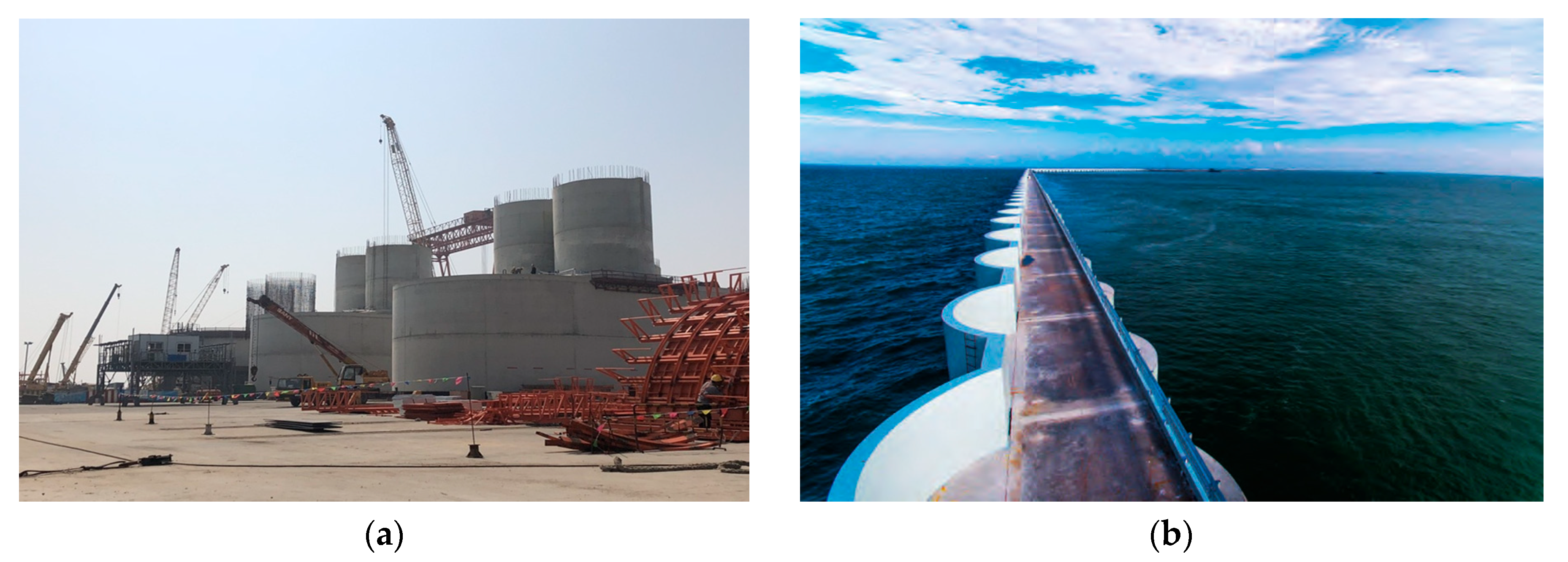
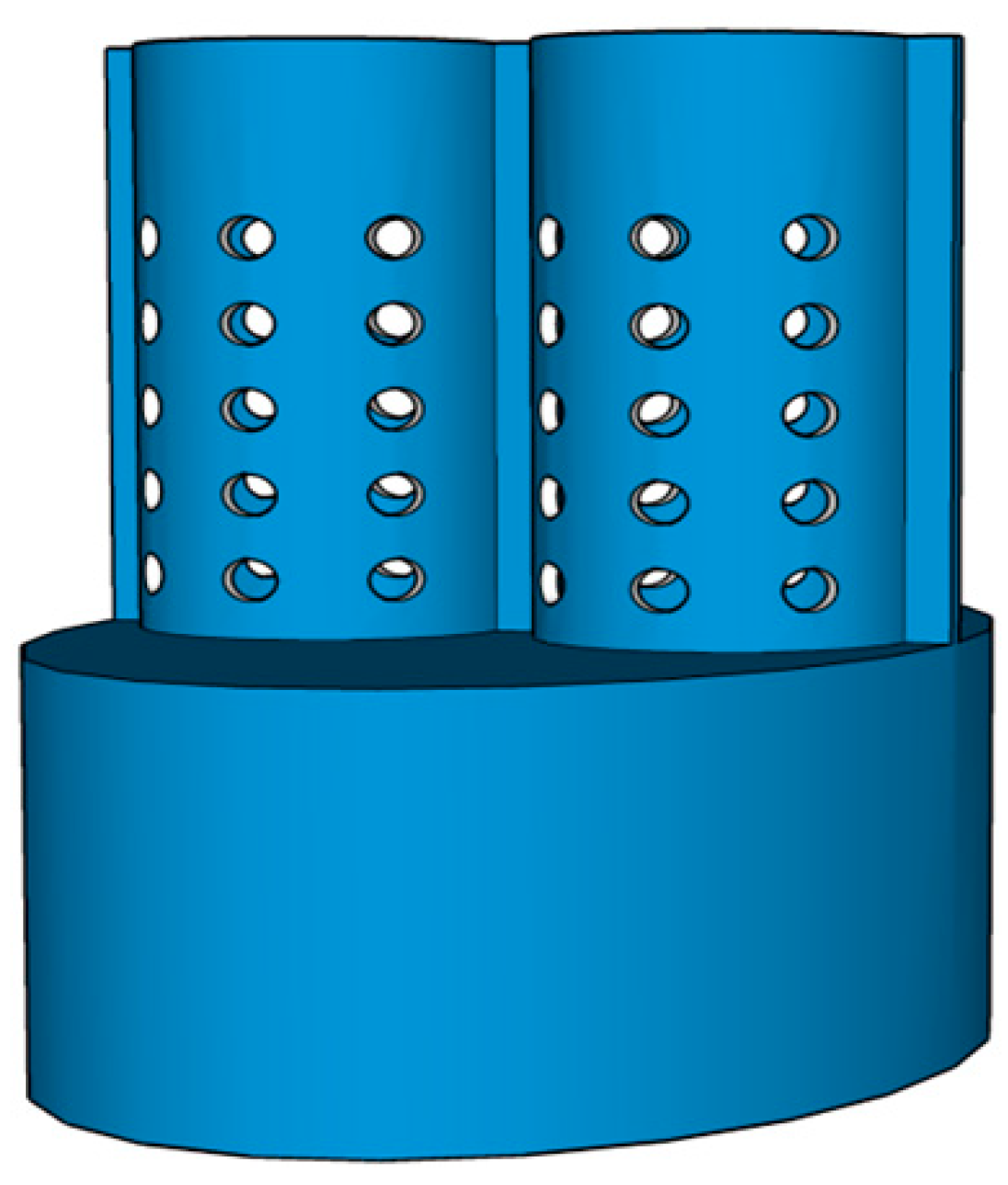
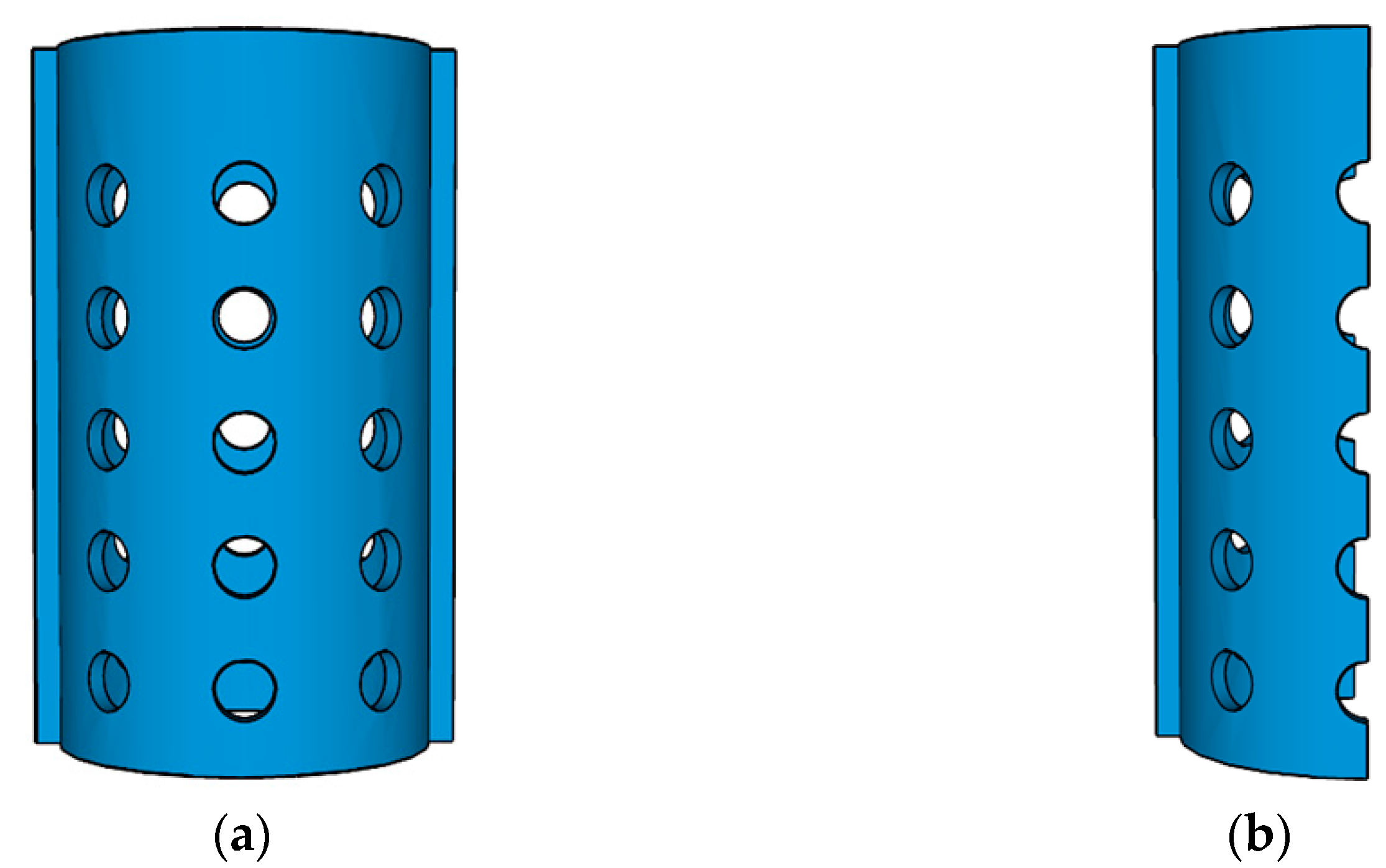
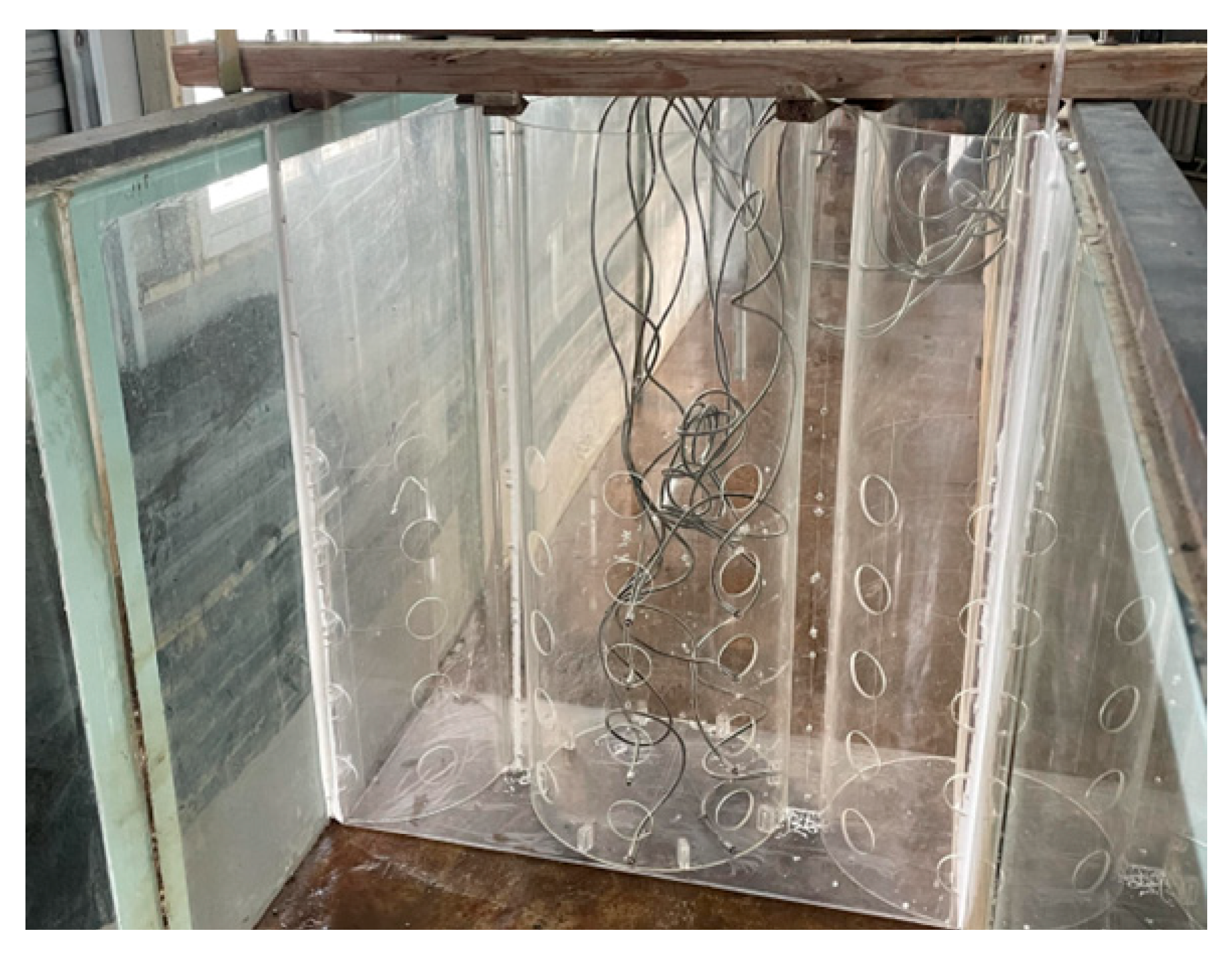
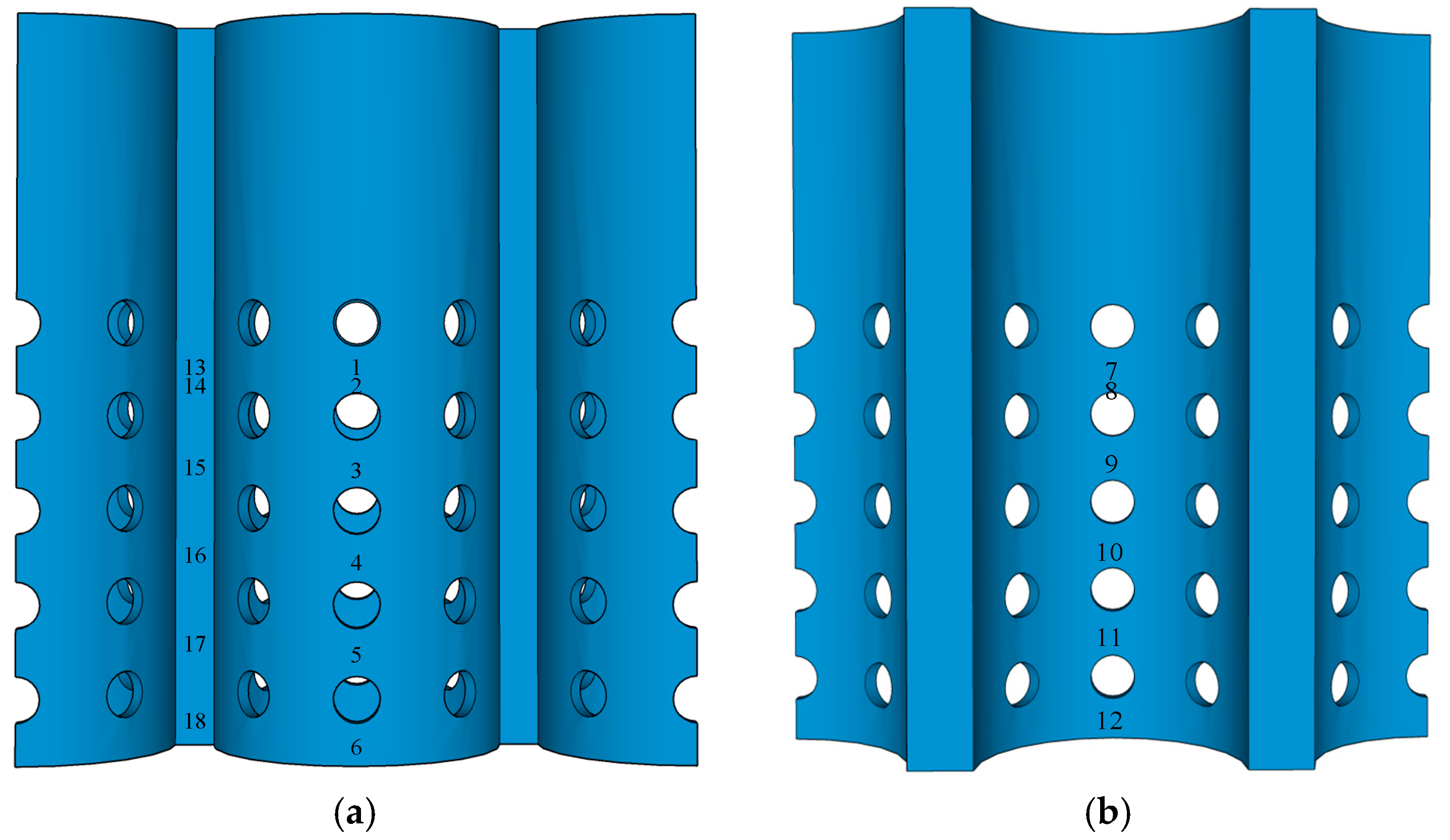


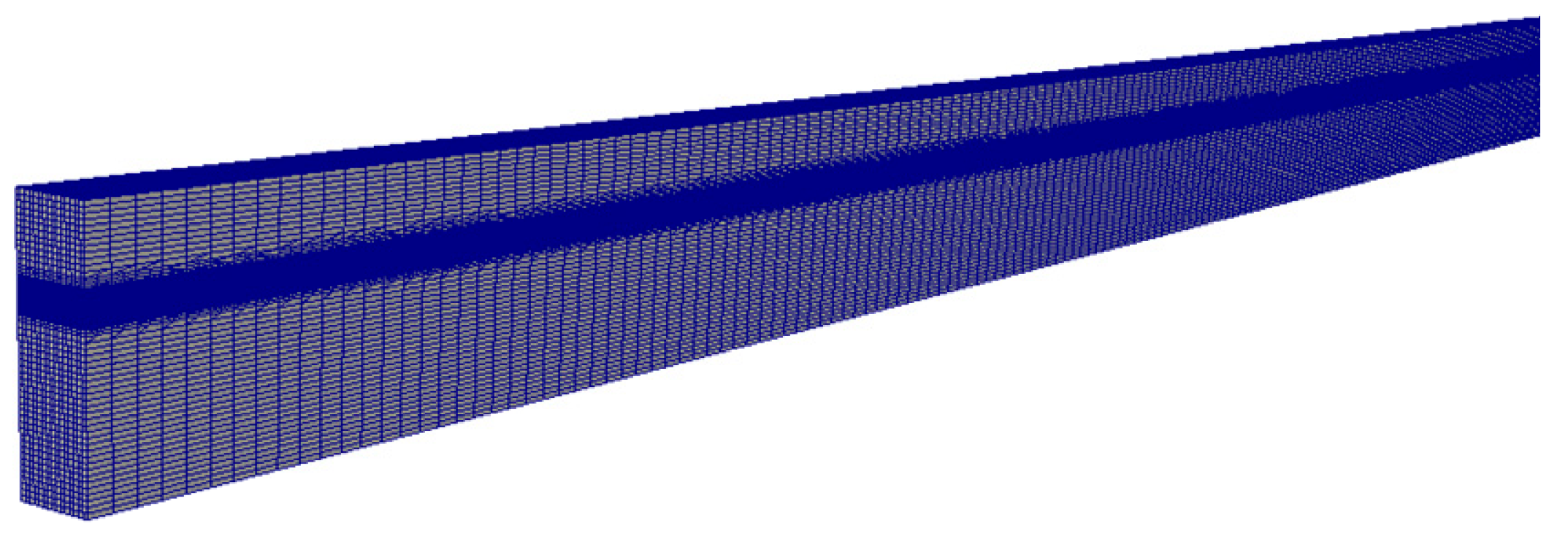
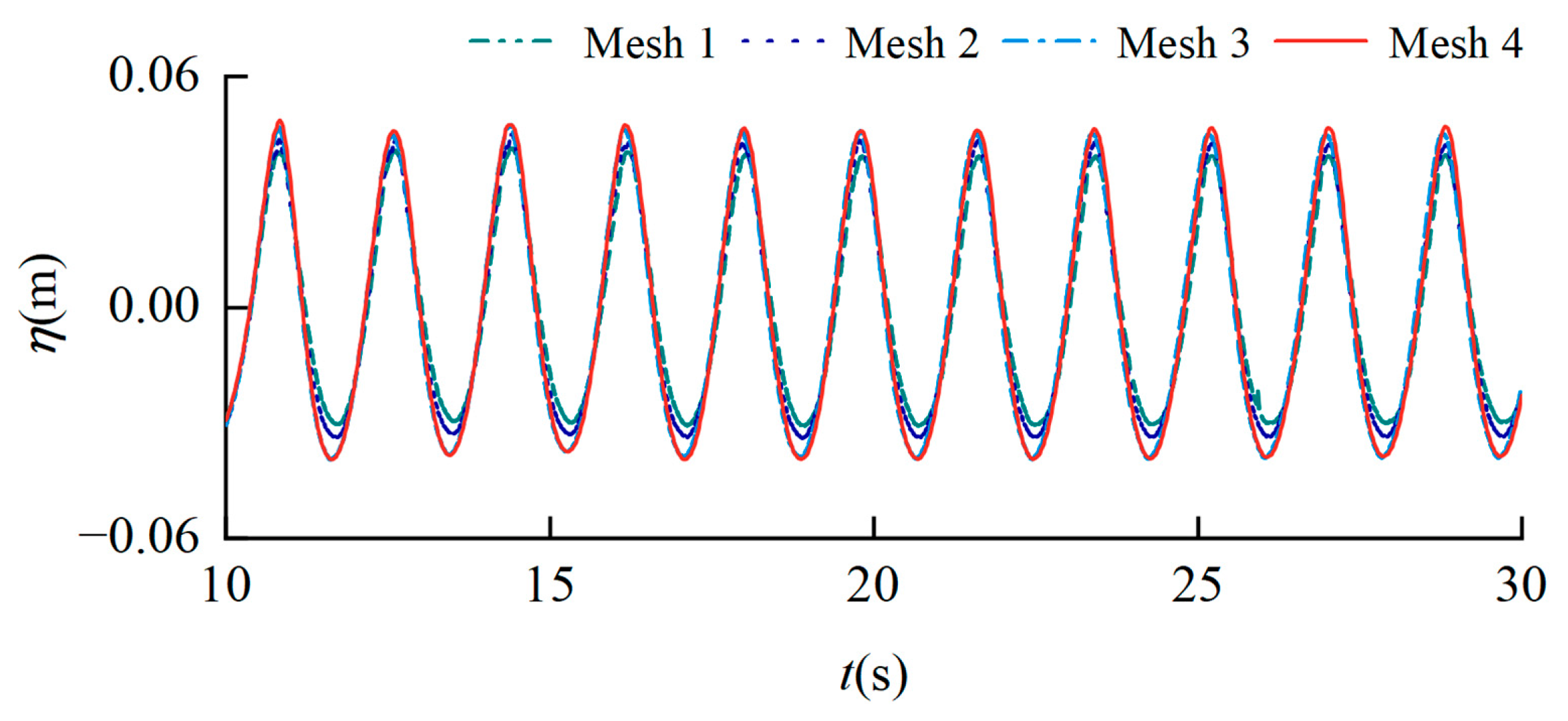
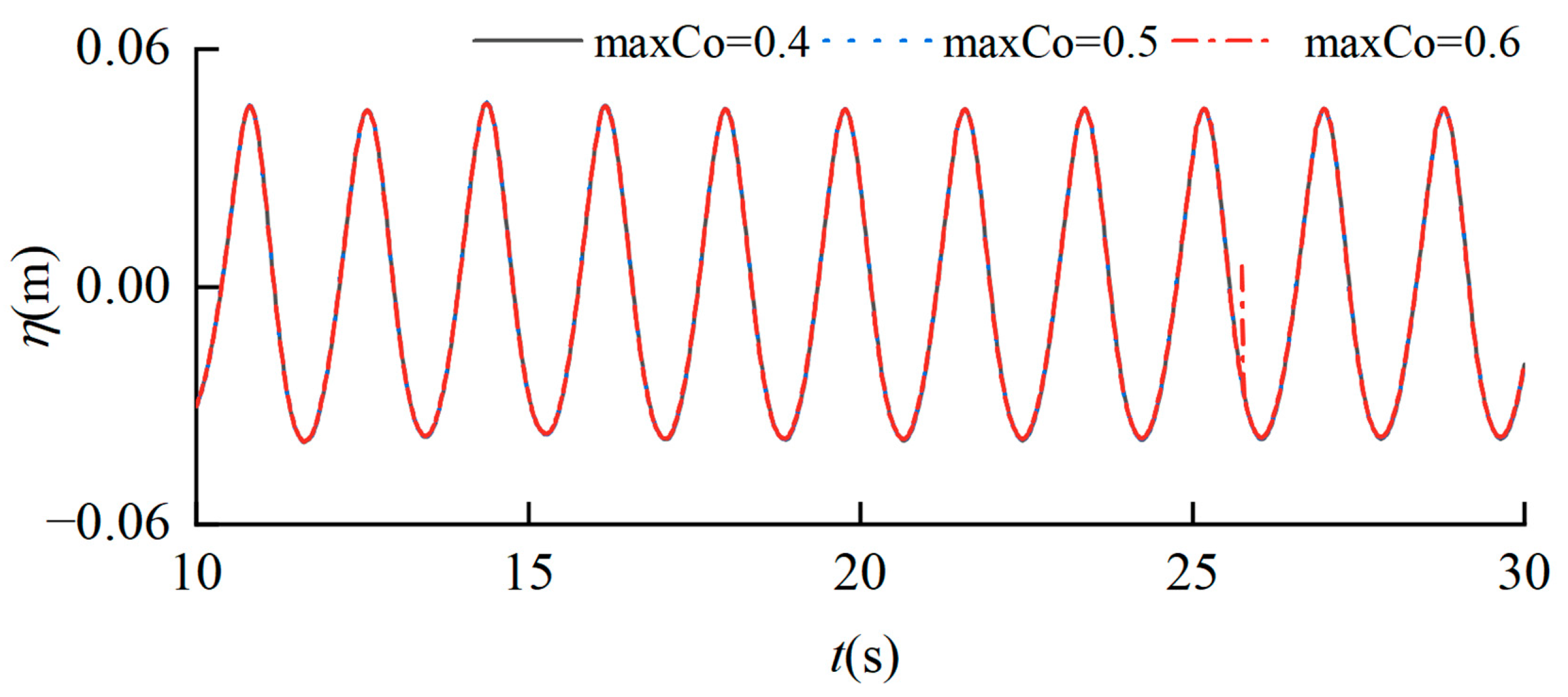
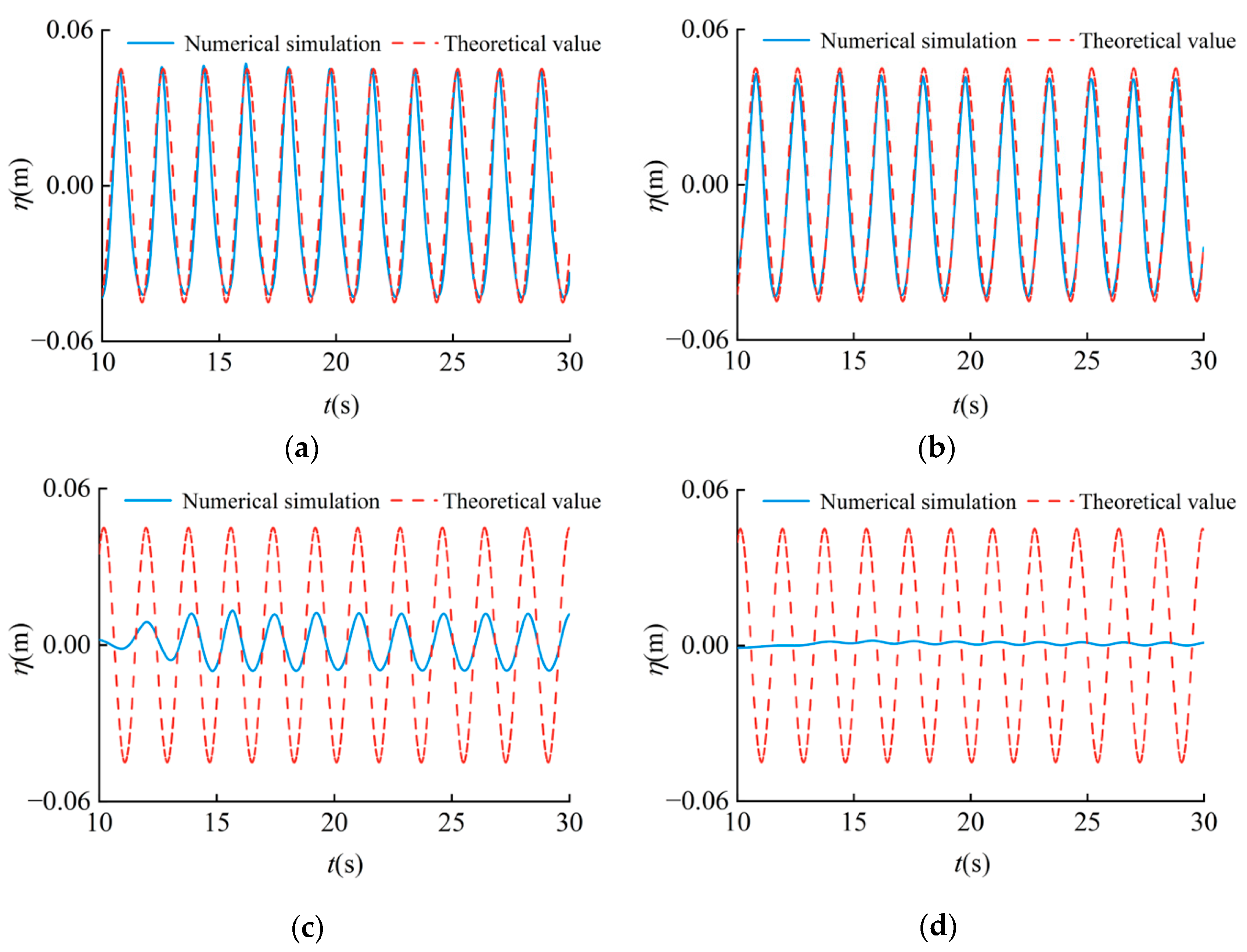


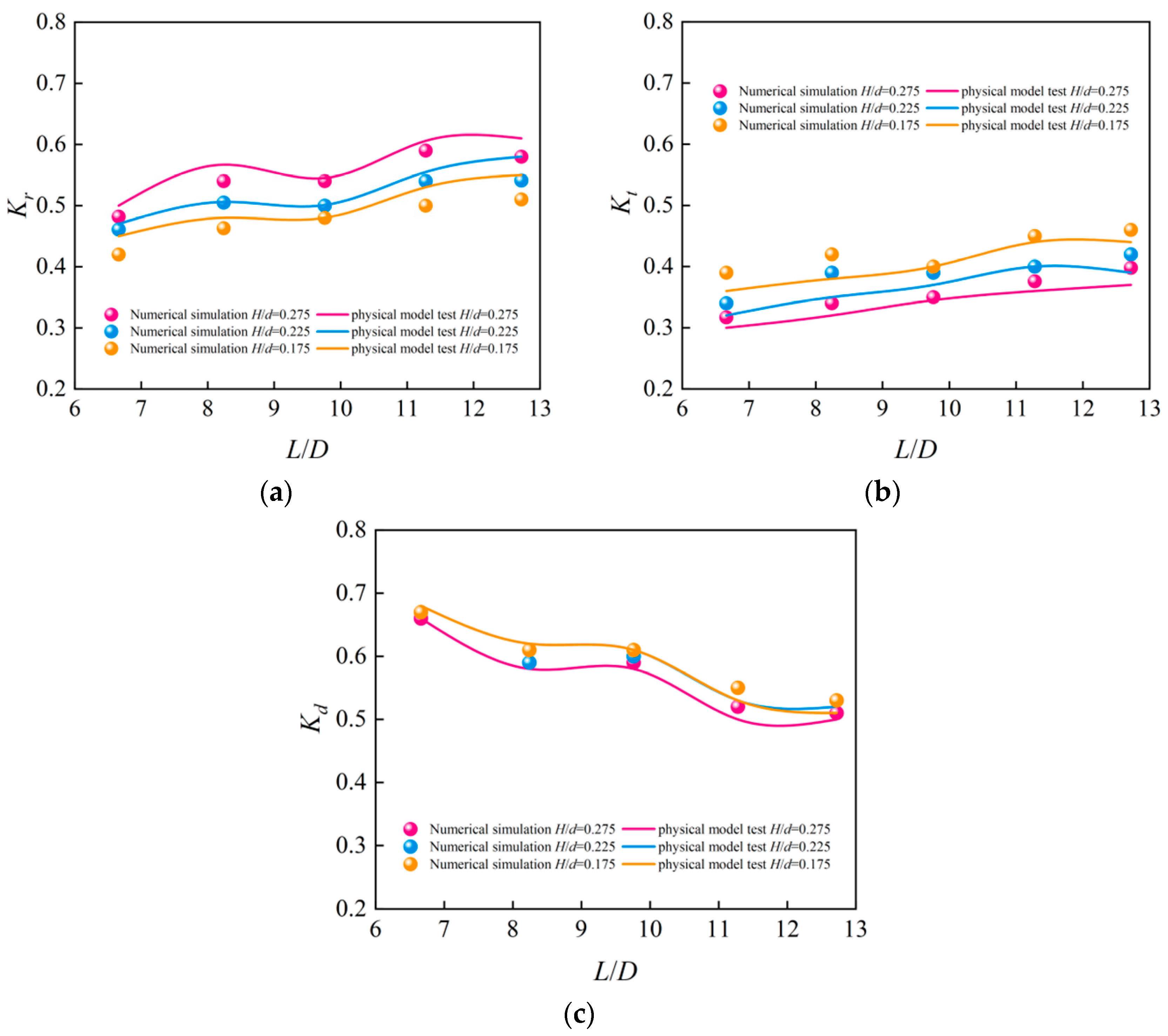


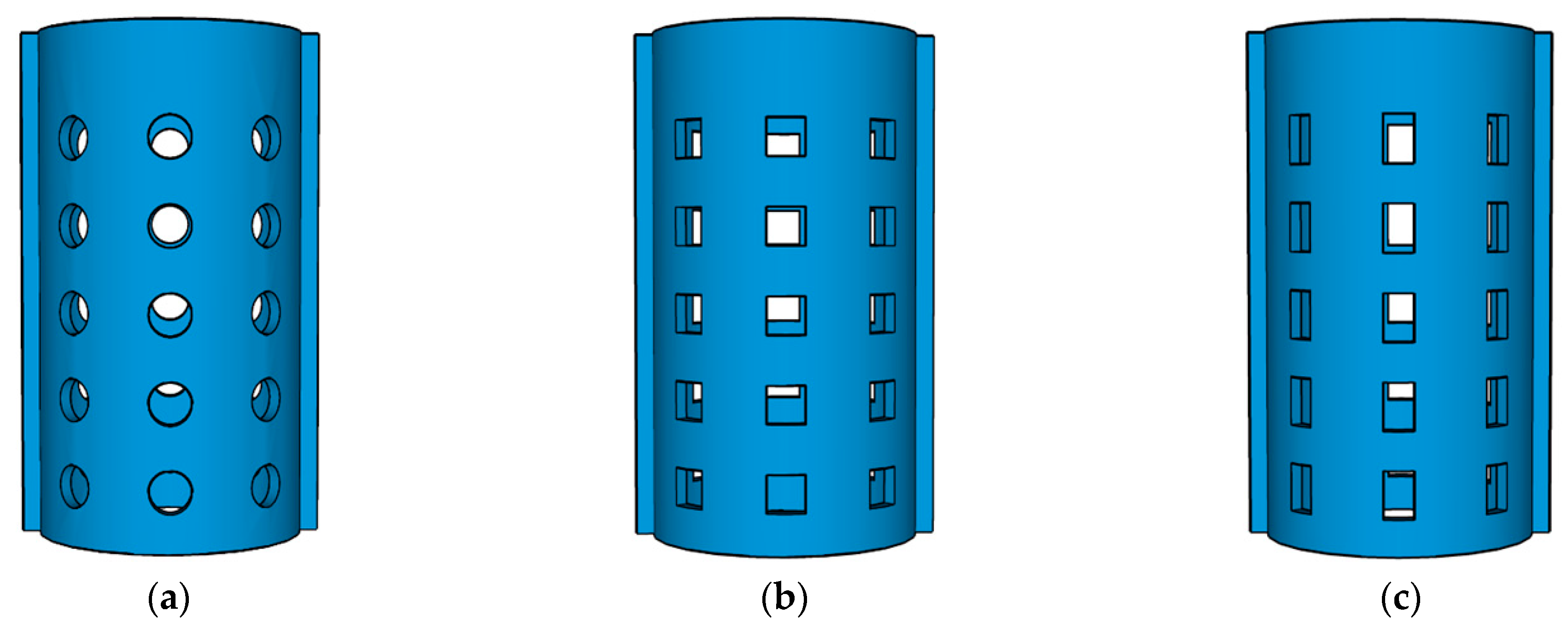

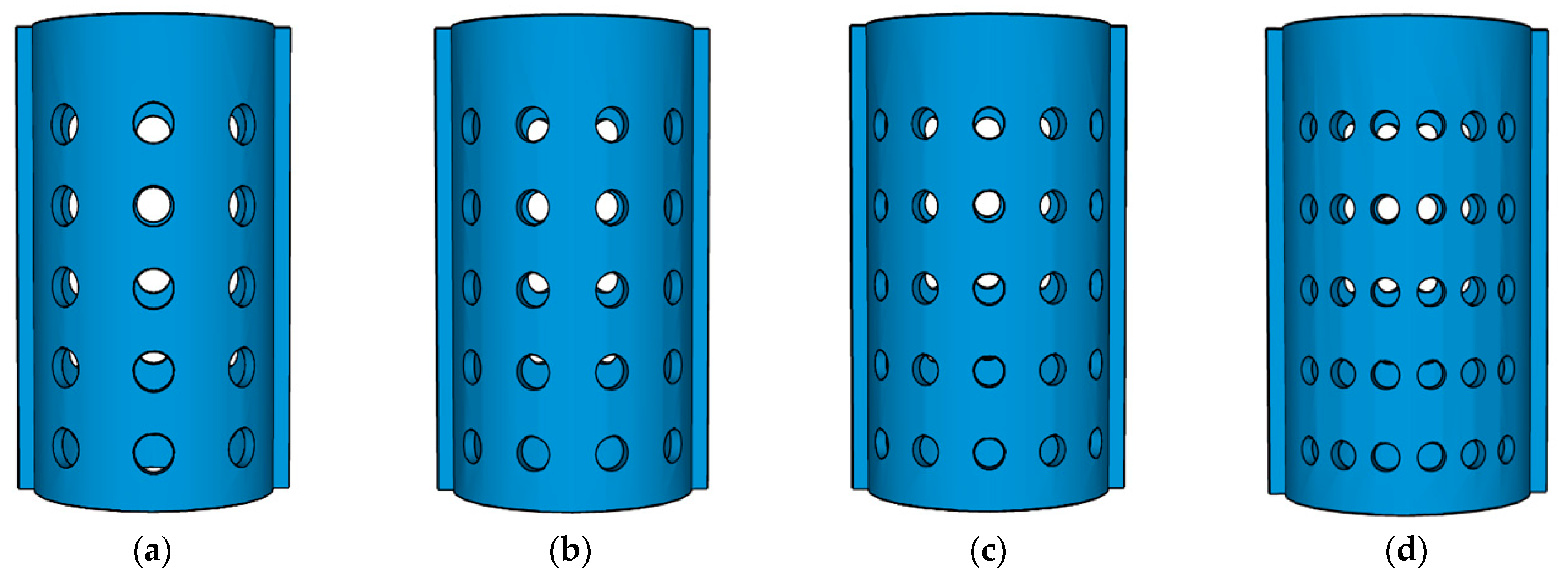

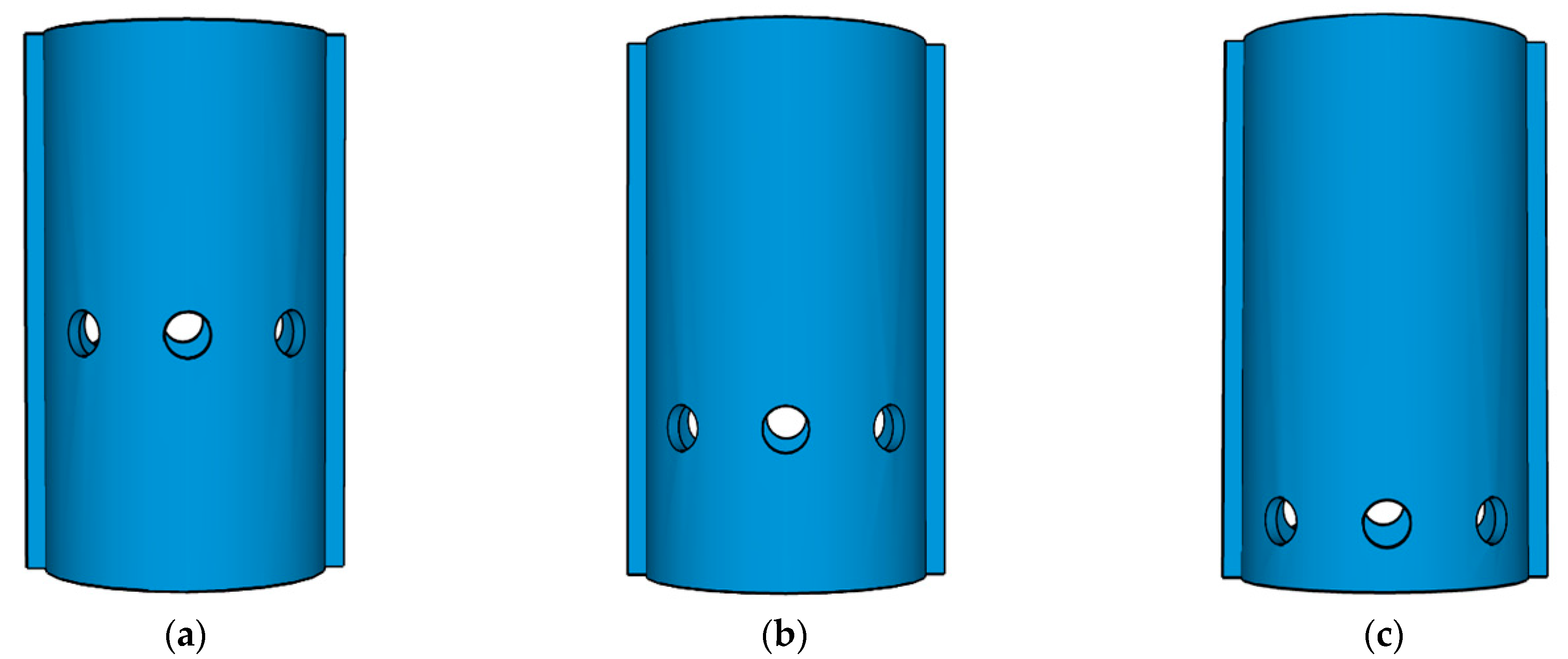



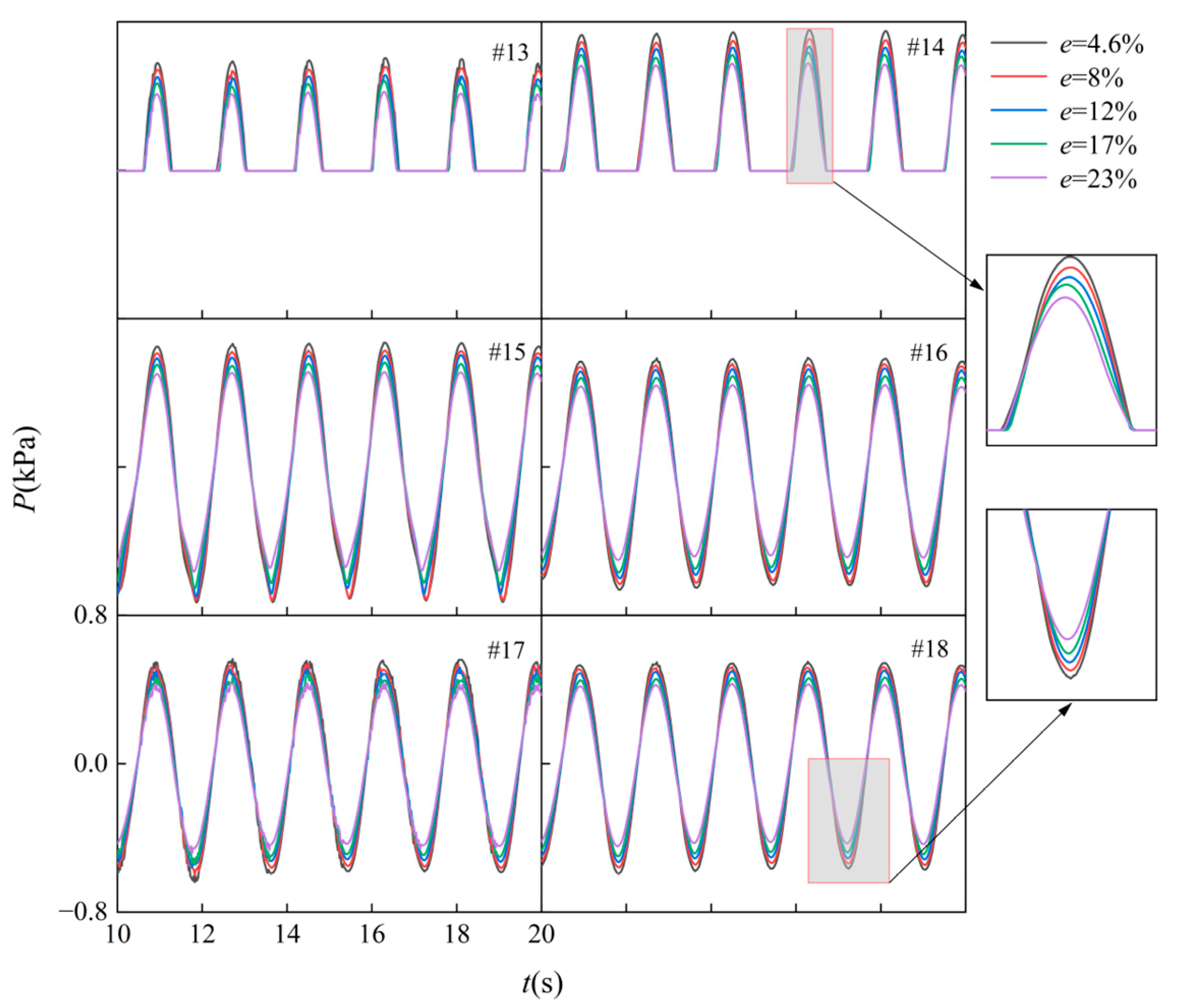

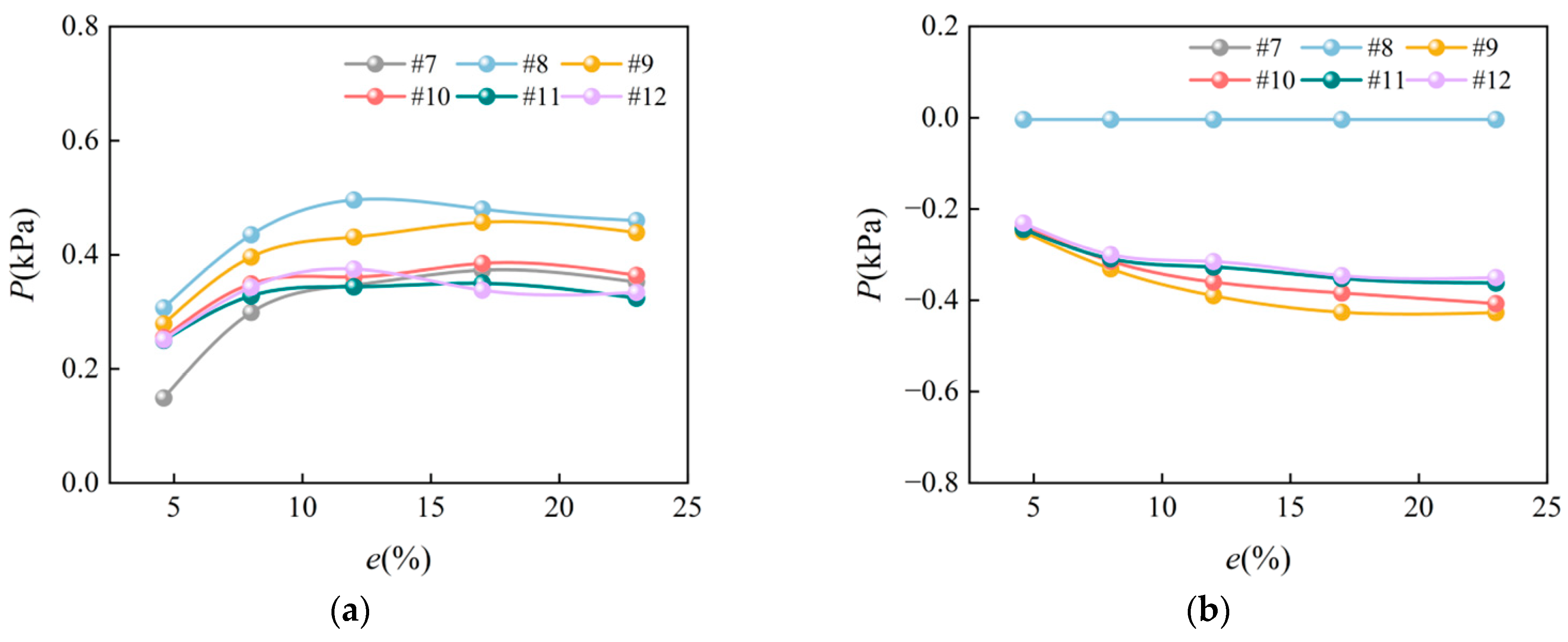
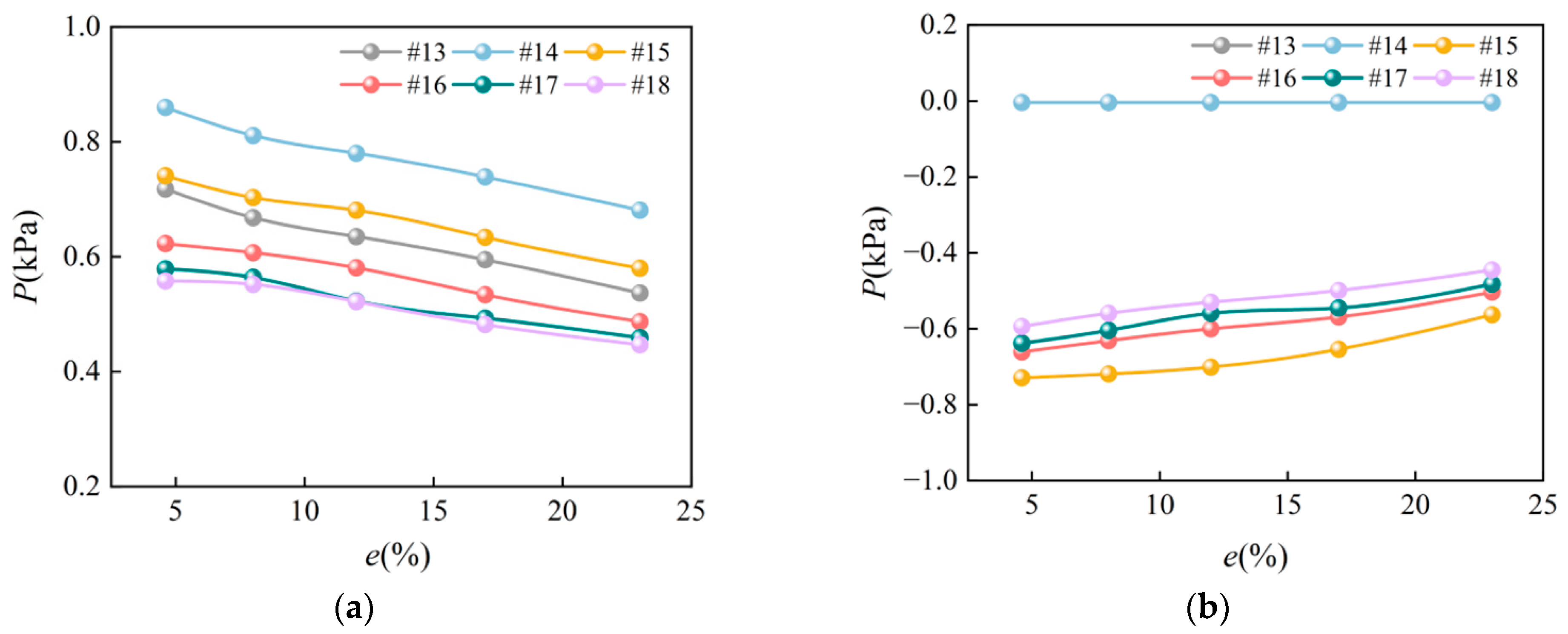
| Case Number | Cell Number | ||||||
|---|---|---|---|---|---|---|---|
| 1 | 0.12 | 182 | 0.024 | 8 | 0.024 | 25 | 106,288 |
| 2 | 0.1 | 218 | 0.02 | 9 | 0.02 | 30 | 184,431 |
| 3 | 0.06 | 363 | 0.012 | 15 | 0.012 | 50 | 871,842 |
| 4 | 0.045 | 484 | 0.009 | 20 | 0.009 | 67 | 2,013,440 |
| Mesh | (%) | (%) |
|---|---|---|
| 1 | 24.2 | 0.25 |
| 2 | 15.8 | 0.12 |
| 3 | 7.5 | 0 |
| 4 | 6.3 | 0 |
| T/s | H = 0.11 m | H = 0.09 m | H = 0.07 m | |||
|---|---|---|---|---|---|---|
| Numerical Simulation | Physical Model Test | Numerical Simulation | Physical Model Test | Numerical Simulation | Physical Model Test | |
| 1.2 | 0.32 | 0.30 | 0.34 | 0.32 | 0.39 | 0.36 |
| 1.4 | 0.34 | 0.32 | 0.39 | 0.35 | 0.42 | 0.38 |
| 1.6 | 0.35 | 0.34 | 0.39 | 0.37 | 0.40 | 0.40 |
| 1.8 | 0.37 | 0.36 | 0.40 | 0.40 | 0.45 | 0.44 |
| 2.0 | 0.39 | 0.37 | 0.42 | 0.39 | 0.46 | 0.44 |
| T/s | H = 0.11 m | H = 0.09 m | H = 0.07 m | |||
|---|---|---|---|---|---|---|
| Numerical Simulation | Physical Model Test | Numerical Simulation | Physical Model Test | Numerical Simulation | Physical Model Test | |
| 1.2 | 0.49 | 0.50 | 0.46 | 0.47 | 0.42 | 0.45 |
| 1.4 | 0.54 | 0.56 | 0.51 | 0.51 | 0.46 | 0.48 |
| 1.6 | 0.54 | 0.55 | 0.5 | 0.5 | 0.48 | 0.48 |
| 1.8 | 0.59 | 0.61 | 0.54 | 0.56 | 0.50 | 0.53 |
| 2.0 | 0.58 | 0.60 | 0.54 | 0.58 | 0.51 | 0.55 |
| Parameters | Specific Values |
|---|---|
| Water depth d/m | 0.4 |
| Period T/s | 1.8 |
| Wavelength L/m | 3.27 |
| Wave height H/m | 0.07/0.09/0.11 |
| Opening ratio e/% | 4.6/8/12/17/23 |
| Number of openings/unit | 3/4/5/6 |
| Opening center position/m | 0.27/0.17/0.07 |
Disclaimer/Publisher’s Note: The statements, opinions and data contained in all publications are solely those of the individual author(s) and contributor(s) and not of MDPI and/or the editor(s). MDPI and/or the editor(s) disclaim responsibility for any injury to people or property resulting from any ideas, methods, instructions or products referred to in the content. |
© 2024 by the authors. Licensee MDPI, Basel, Switzerland. This article is an open access article distributed under the terms and conditions of the Creative Commons Attribution (CC BY) license (https://creativecommons.org/licenses/by/4.0/).
Share and Cite
Yuan, A.; Wang, D.; Jiang, Y.; Wang, Y.; Gui, J. Numerical Investigation of the Hydrodynamic Characteristics of a Novel Bucket-Shaped Permeable Breakwater Using OpenFOAM. J. Mar. Sci. Eng. 2024, 12, 1574. https://doi.org/10.3390/jmse12091574
Yuan A, Wang D, Jiang Y, Wang Y, Gui J. Numerical Investigation of the Hydrodynamic Characteristics of a Novel Bucket-Shaped Permeable Breakwater Using OpenFOAM. Journal of Marine Science and Engineering. 2024; 12(9):1574. https://doi.org/10.3390/jmse12091574
Chicago/Turabian StyleYuan, Anqi, Dongxu Wang, Yuejiao Jiang, Yifeng Wang, and Jinsong Gui. 2024. "Numerical Investigation of the Hydrodynamic Characteristics of a Novel Bucket-Shaped Permeable Breakwater Using OpenFOAM" Journal of Marine Science and Engineering 12, no. 9: 1574. https://doi.org/10.3390/jmse12091574






